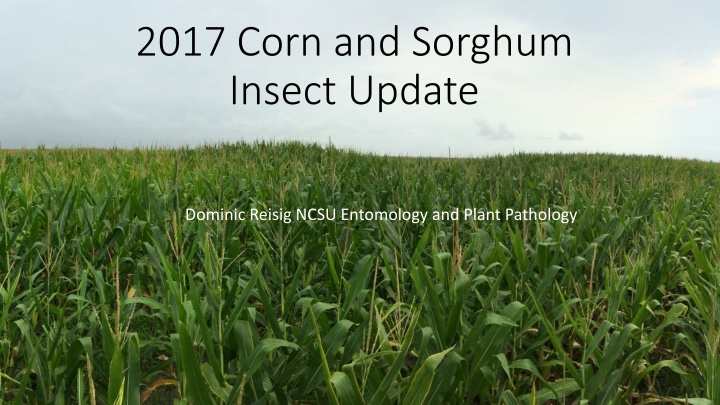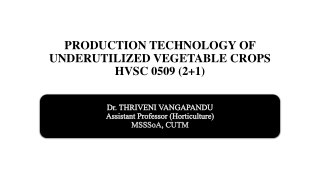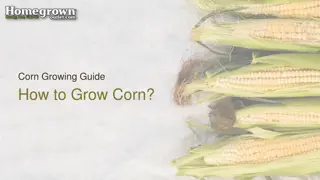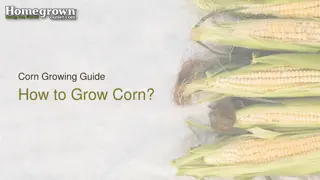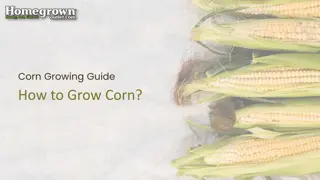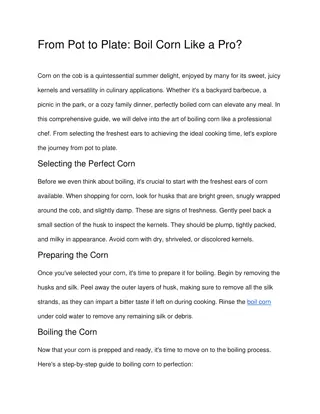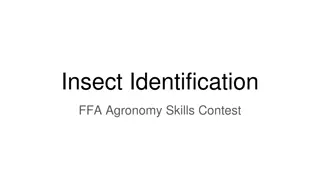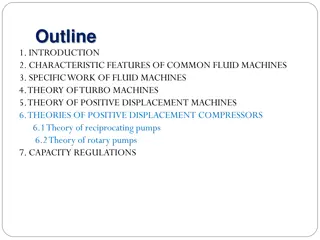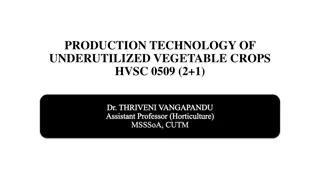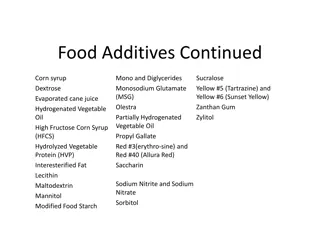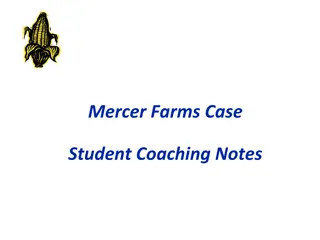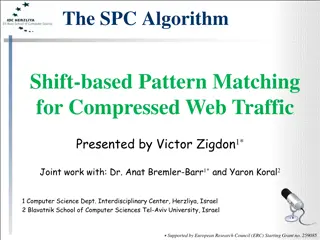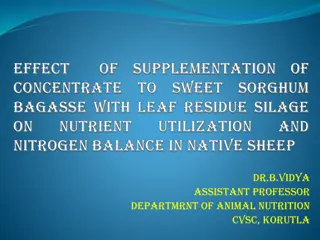Insect Management Update for Corn, Sorghum, and Sugarcane Aphids
Explore the latest updates on insect management for corn, sorghum, and the impact of sugarcane aphids. Learn about potential yield loss, thresholds for management, best insecticides, current issues in corn, and strategies for effective pest control. Stay informed to protect your crops and optimize production.
Download Presentation

Please find below an Image/Link to download the presentation.
The content on the website is provided AS IS for your information and personal use only. It may not be sold, licensed, or shared on other websites without obtaining consent from the author.If you encounter any issues during the download, it is possible that the publisher has removed the file from their server.
You are allowed to download the files provided on this website for personal or commercial use, subject to the condition that they are used lawfully. All files are the property of their respective owners.
The content on the website is provided AS IS for your information and personal use only. It may not be sold, licensed, or shared on other websites without obtaining consent from the author.
E N D
Presentation Transcript
2017 Corn and Sorghum Insect Update Dominic Reisig NCSU Entomology and Plant Pathology
Potential yield loss if not managed Grain producers Pre-boot Boot Heading Soft dough 81-100% 52-69% 67% 21% Sweet sorghum producers Brix can drop to unusable level in several days Can reduce syrup amount recovered Renders a bitter taste and off flavors to syrup
Simple threshold Pre-boot through boot 20% plants infested with localized areas of heavy honeydew and established colonies Heading through dough stage 30% plants infested with localized areas of heavy honeydew and established colonies Preharvest Aphids on the flag leaf or grain head causing harvest problems with honeydew http://sorghumcheckoff.com/pest-management/
Best insecticide for sugarcane aphid 160 a 140 Aphid number per leaf 120 a 100 ab ab 80 aab abcd 60 abc abcde ab 40 ab abc 20 bc abcabcbc c cd de ab b b b e 0 3 DAT 10 DAT 17 DAT Untreated Lorsban 2 pt Dimethoate 1 pt Centric 2.5 oz Transform 1 oz Sivanto 7 oz Transform 1.5 oz Sivanto 4 oz
Current issues in corn Over-reliance on insecticidal seed treatments Timely planting Weed management Rotate away from corn Use starter fertilizer Ensure proper drainage Stink bugs Corn earworm
Corn Insecticide Seed Treatments Can I boost a seed treatment with an in-furrow? Any new products out there? What can we do if we lose insecticide seed treatments?
Wireworm North Carolina Corn 2014 2015 Melanotus communis Conoderus lividus 10% 16% Conoderus vespertinus Glyphonyx spp. Conoderus lividus Conoderus lividus 16% Conoderus vespertinus 11% Conoderus vespertinus Melanotus communis Melanotus communis Melanotus communis Conoderus lividus Conoderus vespertinus Glyphonyx spp. Glyphonyx spp. Glyphonyx spp. 58% 62% 11% 16%
Wireworm North Carolina Corn 0 = No Control, 2 = Poor Control, 4 = Marginal Control, 6 = Fair Control, 8 = Good Control, 9 = Excellent Control 7.00 Poncho 1250 N = 4 6.50 Poncho 500 N = 4 6.50 Cruiser 500 N = 1 6.00 Poncho 1250 + Counter 10 lb N = 3 5.50 Poncho 500 + Counter 6.5-10 lb N = 4 5.00 Counter 6.5-10 lb N = 4 4.50 Capture LFR 4-6.4 oz N = 4 4.50 N = 2 Poncho 250 + Smartchoice 3-5oz N = 2 4.25 Poncho 250 + Capture LFR 4 oz N = 2 4.00 Poncho 250 N = 1 3.8 Smartchoice 5oz 0 1 2 3 4 5 6 7 8 9 Mean Rating
A 2.5 and w hite grub injured plants M ean num ber of w irew orm 2.0 per 24-row m eters AB AB B AB AB B 1.5 1.0 0.5 0.0 clothianidin 1.235m g a.i./ha + terbufos clothianidin 3.088m g a.i./ha + terbufos clothianidin 1.235m g a.i./ha clothianidin 3.088m g a.i./ha bifenthrin terbufos U ntreated
Lumivia chlorantraniliprole Labeled use rate from 0.25 to 0.75 mg per seed (250 to 750) Offering on newer DuPont/Pioneer hybrids Cruiser 250 + Lumivia 250 Anticipate no problems with maximum labeled season rate for chlorantraniliprole Highest use rate of Lumivia still leaves room for nearly two sprays of Prevathon at 14 oz Do not apply other seed treatment products to seed already treated with Lumivia
Summary of Five Greenhouse Trials Mean SE % wireworm mortality 50.5 9.0 Mean SE % healthy corn seedlings 81.5 10.9 Mean SE % damaged seeds Rate ug AI/seed Treatment Lumivia 625FS + Cruiser 5FS 250 + 250 1.5 0.6 Poncho Votivo Poncho 600FS Cruiser 5FS Untreated Check 1,250 500 250 - 2.0 0.9 1.0 0.6 2.5 1.1 27.5 9.0 62.5 11.0 58.0 9.6 50.0 9.7 6.5 3.2 87.0 8.1 77.5 5.8 87.0 4.5 68.0 10.1 Tom Kuhar, VA Tech
Virginia Beach- Moderate Wireworm Pressure Stand count/ 25 row ft 26 DAP Mean plant height (cm) 43 DAP % stunted plants 26 DAP Grain Yield (lbs/25 row ft) Treatment Lumivia 625FS + Cruiser 5FS 250 + 250 30.0 3.3 b 35.8 ab Poncho Votivo Poncho 600FS Cruiser 5FS Untreated Check 1,250 500 250 - 25.0 25.0 30.0 29.8 1.7 b 0.0 b 4.2 b 50.4 a 37.6 ab 39.5 a 33.9 ab 29.7 b Tom Kuhar, VA Tech
White Grub North Carolina Corn 0 = No Control, 2 = Poor Control, 4 = Marginal Control, 6 = Fair Control, 8 = Good Control, 9 = Excellent Control N = 6 8.00 Poncho 1250 N = 3 7.50 Capture LFR 6.4oz N = 1 7.50 Cruiser 250 + Lumivia 250 + Capture LFR 6.4oz N = 1 6.00 Poncho/Votivo N = 2 6.00 Poncho 500 N = 2 6.00 Poncho 1250 + Counter 10lb N = 2 6.00 Poncho 500 + Counter 10 lb 6.00 N = 1 Poncho 250 + Lumivia 250 N = 4 6.00 Cruiser 250 + Lumivia 250 N = 1 5.50 Poncho 250 N = 4 5.50 Cruiser 250 0 1 2 3 4 5 6 7 8 9 Mean Rating
8 2014 M ean root weight (g) per plant 2015 a 6 ab A b c b c b c b c c AB AB AB 4 ABC BC A 2 0 clothianidin 1.235m g a.i./ha + terbufos clothianidin 3.088m g a.i./ha + terbufos clothianidin 1.235m g a.i./ha clothianidin 3.088m g a.i./ha bifenthrin terbufos U ntreated
Effectiveness of Lumivia for White Grubs Yield White grub injury 3 WAP 230 30 a White grub-injured plants per 80 row-feet a 220 25 ab ab ab ab 210 20 ab Bu/A abc ab 200 abc 15 b abc 190 10 bc c 180 5 170 0
Lumivia Untreated Poncho 1250
Seed Treatments vs. In-Furrow for White Grubs A 220 AB AB 210 ABC 200 ABC Yield (bu/A) ABC BC 190 BC 180 C 170 160 150
Lumivia- Hyde Co. 2014 0.07 a 0.06 Untreated Lumivia 250 Lumivia 750 Lumivia 500 Poncho 500 Cruiser 250 Poncho 1250 Cruiser 250 + Lumivia 500 Cruiser 250 + Lumivia 250 Injured Plants per Row Foot 0.05 ab 0.04 abc abc 0.03 0.02 bc bc c c c 0.01 0
2014 2015 ?
Cruiser 250 + Lumivia 250 Untreated Poncho 1250
Cruiser 250 + Lumivia Poncho 1250 Untreated
Untreated Poncho/VOTiVO Cruiser 250 + Lumivia Poncho 1250
Percent Plants with Feeding, Southern Corn Billbug - Poncho 1250 Relative to Untreated Corn 100 80 60 40 20 0 -20 -40 -60 2013 2014 2015 2016 Four trials Four trials One trial Two trials
bifenthrin at 6.4 oz/A = 0.025 lbs/A zeta-cypermethrin at 4.0 oz/A= 0.025 lbs/A bifenthrin LC50= 0.1 g/ml zeta-cypermethrin LC50> 1 g/ml
Stink Bug Thresholds Georgia thresholds Prior to VT - 25% infested plants R1 - 50% infested plants R3 - 100% infested plants Spray ~7 days after adjacent wheat harvest
Distribution of stink bugs on seedling corn (V4,V8 & V12) 150 V 12 n = 243 V 8 V 4 n = 88 n = 64 H eight from ground (cm ) 100 50 0 0 10 20 30 40 50 0 10 20 30 40 50 0 10 20 30 40 50 H orizontal distance (cm ) 100 R elative frequency (% ) V 4 V 12 V 8 75 50 25 0 5 105 115 125 135 15 25 35 45 55 65 75 85 95 5 15 25 35 45 2.5 7.5 12.5 17.5 H eight from ground (cm )
Position of growing point in seedling corn in relation to soil level 4 G ro w in g po in t fro m soil level (cm ) 2 0 -2 -4 V 2 V 3 V 4 V 5 V 6 C o rn g ro w th s tag e
32 Vertical distribution of stink bugs on pre and post tasseling stages 150 150 150 150 R 4 R 2 V 14 n = 228 R 1 n = 145 n = 228 n = 207 H eight from ground (cm ) H eight from ground (cm ) H eight from ground (cm ) H eight from ground (cm ) 100 100 100 100 50 50 50 50 0 0 0 0 0 20 40 60 80 0 20 40 60 80 0 20 40 60 80 0 20 40 60 80 H orizontal distance (cm ) H orizontal distance (cm ) H orizontal distance (cm ) H orizontal distance (cm )
